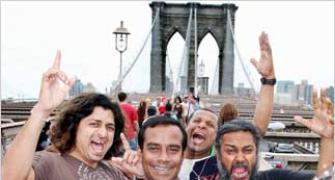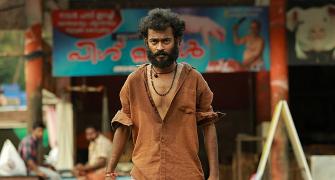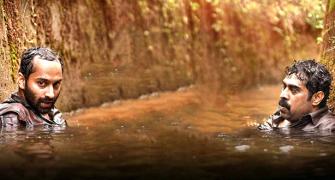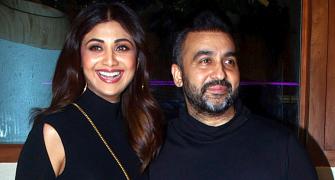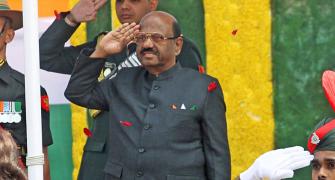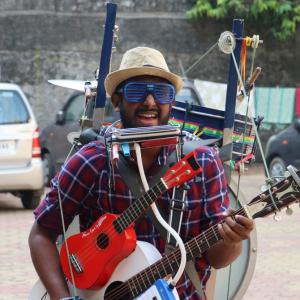'The bumblebees in Par Ek Din may not be flying yet, but even as they dangle in mid-air, their stings hurt.'
'Effortlessly graceful, this is a work of passion that conveys what being passionate about something truly feels like,' says Sreehari Nair.
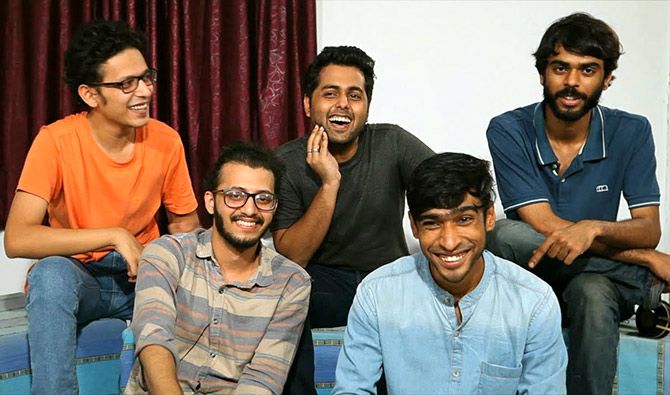
Atonality is at the heart of Jaideep Varma's twinkle-toed Par Ek Din, a documentary film about a music band from Mumbai that's struggling for a point of entry into an audience it can make no sense of.
An early scene has one of the band members, Mallar, getting into an elevator and talking about its strange synaptic misfires: 'If I press seven, it takes me to the eighth floor. And if I press eight, it takes me to the seventh.'
In the closing moments of the 89-minute documentary, another band member Samyak muses about how inapt it would sound if he were to yell 'Sing it!' to a mall crowd and then proceed to sing Mujhe Nahin Rehna Yahaan -- one his album's many protest-numbers.
While the five boys who constitute the band CityHaze grumble about the atonality and dissonance around them, they're also unconsciously turning these jarring elements into music.
The Haze that's supplying their juices is an inseparable part of the City: In the band name, there's no space between the two words.
And while these boys do crave success, nothing would kill them faster than success not achieved on their own terms.
The quintet shares its bohemian spirit with those lost generations that bloomed in the Paris of the 1920s and the Greenwich Village of the 1940s; and even as the group depends on Mumbai for its home, it is simultaneously revolting against the forces that are throttling life in the big city.
Jaideep Varma is a filmmaker with the curiosity of a cultural anthropologist and he too is staging a minor revolt here: Par Ek Din wants to subtly give it to those tabloid pieces that are only fascinated with success stories (As an aside, do we need any more of those god-awful articles with briefs such as: 'Since Ravichandran Ashwin just pocketed a couple of Man-of-the-Series Awards, let's try to hear from the barber, who give him his first mushroom-cut'?).
Varma wishes for his subject a bright future but his aptitude is closer to those New Yorker writers, who are eternally interested in stories from the fringe, in those small pockets waiting to become the intellectual cafes of tomorrow.
Working with Harshad Nalawade (who has shot and co-edited the film), Varma takes us inside these boys' heads as they recount their histories, and give us their half-formed thoughts and side glances (they all have eyes with something roiling in their surface).
And without ever overtly striving for it, Varma and Nalawade reveal their arcs to us: how the boys have erased and redrawn themselves over the course of their journeys, and how they've redesigned the way they talk, think, and even feel.
By intercutting their music-making with their philosophies about music, the film captures these young artists as they attempt to become their own avant garde.
But all through this, Par Ek Din is careful about not turning into a mouthpiece for the band.
Quite the opposite, in fact.
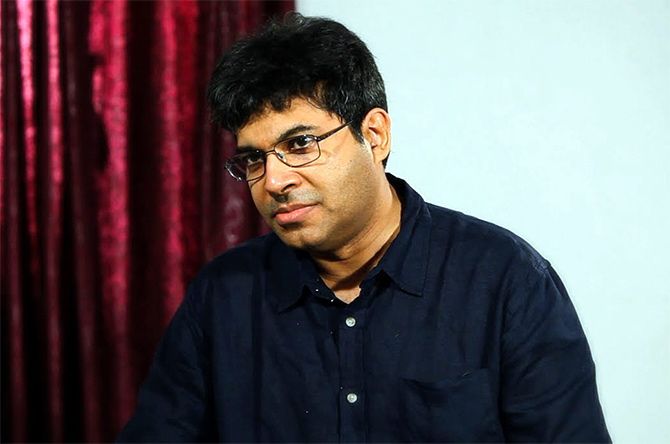
He sees them as a mix of the crackpot, the wrong, and the incredibly, profoundly right, and yet 'complete' with their many contradictions.
Jaideep Varma is aware of how music bands function behind the stage, about how egos can flare up in a matter of seconds and how verbal inchoateness can find its way into lyricism; his questions for CityHaze's members are often phrased like trick questions
(At one point, when a band member casually mentions the word 'sellout,' he interrupts them with a 'At 25, what can you possibly know about selling out?').
Varma doesn't mock the bumblebees, but he knows their disease and knows when to twist the knife.
He sees them as a mix of the crackpot, the wrong, and the incredibly, profoundly right, and yet 'complete' with their many contradictions.
The boys are in awe of Varma, they worship his CV (Varma's Leaving Home, his documentary about the band Indian Ocean, is cited as a turning point), and they want to impress him with the depth of their thoughts.
However, what they mostly have to offer are the usual platitudes: 'The grass is greener on the other side,' 'Light at the other end of the tunnel,' and what have you.
These boys are artists in their own heads, but they are also images of what they think an artist should be. And because the interviews and the renditions are presented with very few cutaways, we catch them as they mythologise themselves and their band -- watching the process happen as it happens.
There's a lot of underlying intelligence in the documentary, but when Nalawade and Varma get together to do their little voiceovers, they come off as two runaway talents trying to call attention to themselves.
This film, with its generosity and airiness, is already pitched so high up in a space where the audience can form their own interpretations that it didn't need those meta commentaries.
The voiceovers essentially belong to the world of in-the-face mockumentaries that Par Ek Din naturally transcends.
Nalawade gives the band members, unhindered shots, but his cuts, while seemingly simple, often shoot out telling poetry.
For example, there's a bit when the boys talk about their percussionist, Soham, who's a first-rate tabla player (a tabla purist in the truest sense), but who -- since joining the band -- has made the switch to playing the keyboard.
At this point, Nalawade cuts to a recording of the song Imaan which talks about original loves, and the end of innocence and conscience ('I had a conscience which wasn't of any use,' the song goes).
Death of innocence is in fact the theme that binds all the 11 songs of the CityHaze album; songs which talk about escaping into a better world away from the city, returning to small-town roots, and life at the end of kingship.
The lyrics are a cross between liberal aphorisms and revolution-claptraps; they're only half-felt and this imperfection is a big part of their charm.
These songs about the death of innocence are sometimes almost too innocently straight.
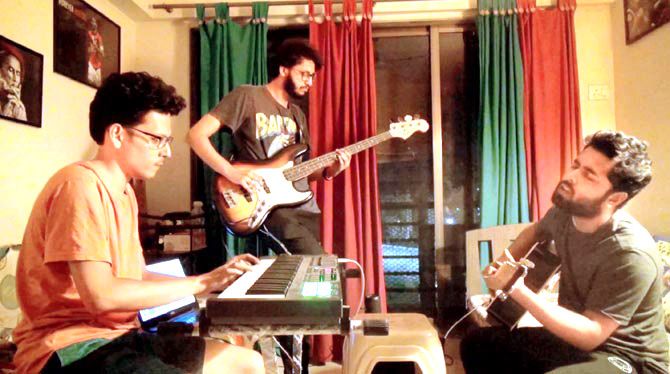
Throughout the film, we see music being made but without any of the monkeyshines we logically associate with bands; we see the trance, but none of the drug.
And it's this dour matter-of-factness -- which could only have been achieved through a documentary -- that jolts us up.
Engaged in their strumming and singing we can almost hear the boys talking to themselves while sub-vocalising:
'Is this thing worthy of being turned into a song?'
'What is that one enduring personal experience I want to bring to this number?'
'How would my Music Gods have composed this one?'
To think about it, these are the kind of questions, that a filmmaker trying to get through his first picture or a novelist trying to write her first novel, also come up against.
The five performers are super-careful that their styles don't become parodies of stage poses; so much so that Mallar, who's also designated as the 'Producer,' stands barefoot when he plays the guitar in front of a studio audience.
Mallar is more of a music critic-turned-musician -- he's like those post-modern writers who were the first generation of writers that read art criticism, and whose text therefore reflected that self-consciousness.
'Let us stay clear of clichés,' Mallar declares to his group at one point, and when Soham, Samyak, Abhigyan (the bass guitarist), and Debatra (the drummer), discuss the viability of their music, Mallar keeps out of the discussion completely -- both sultry enthusiasm and fear of rejection are not for him; he's too much at peace with himself. Amo, ergo sum.
Between Samyak and Mallar, there's an evident clash of personalities.
And it's only natural; for Samyak is the vocalist who took to music because he was inspired by his parents and Mallar is the rebel who took to loud sounds because his parents loved the classical stuff.
Samyak's dreams (both for himself and the band) are simpler and Mallar beats him at the speed of thought.
There are slight tensions brewing between Mallar and Samyak, attributable mainly to the fact that Mallar is the kind of leader who can induce Machiavellian traits in those around him.
This is one of the great achievements of Par Ek Din: Watching it is like being hauled away to a great party where you listen to its hosts as they tell you their tales and sing to you lovely sad songs, and as you hear them you're also making guesses about how the party may eventually snap off and how the band 'may' come to its ultimate demise.
There's no easy brotherhood here to take heart from; only passions that cross-current.
The boys don't yet have the one-headedness of established teams.
For example, Abhigyan, the bass guitarist, is the outsider they have welcomed in because they think he is as annoying and as child-like as them.
In the course of the documentary, however, Abhigyan proves them wrong when he sits alone, away from the gang, as they watch a WWE match on TV.
They call it 'Performance Art' (Is this the 'return to simpler times' they are talking about through their songs?) even as Abhigyan sincerely rants, "I can't believe 25 year olds have to rely on this thing for entertainment."
As the documentary pitches forward, the atonality and dissonance become more felt, and the songs progressively go from being Shout-outs to Expressions of Epiphany.
The boys feel betrayed by those closest to them -- which is often the case with artists trying to break out on their own.
'Nobody says anything about the songs,' Samyak broods. 'If we don't do it, who will? We are all privileged fucks, right?'
With the hollow cynicism at the start now replaced by honest disillusionment, CityHaze's songs start to flow out better, and even as the very fabric that created the band now looks a tad disturbed it tightens their feeling for what's being sung away.

In the beginning, we hear the group talk about 'loss of innocence' but it's only by the end that we actually see them experiencing it -- it's not a phrase anymore for them, but a reality they confront every day.
While it stays close to the band members recording their madmen-like spews, Par Ek Din, in the midst of it all, slowly turns against its viewer.
It is a real slap in the face for us when we see the five boys go about their obsession, despite all the discouragement and lack of recognition.
CityHaze's songs may not be exactly revolutionary, but this film raises uncomfortable truths -- not so much about how fearless we are or aren't about following our calling, but about how cold we've always been to a tune we haven't heard or to a consciousness we haven't traversed.
For all the talk about Freedom of Expression and Crowd-funding, we are left wondering about how much have things changed for that artist who's not willing to play the con-man -- about how different are these times to the days when The Rite of Spring was jeered at, or when Ulysses was burnt.
The bumblebees in Par Ek Din may not be flying yet, but even as they dangle in mid-air, their stings hurt.
Effortlessly graceful, this is a work of passion that conveys what being passionate about something truly feels like.

